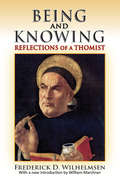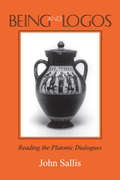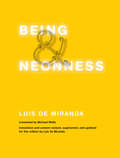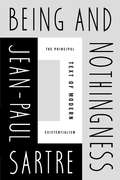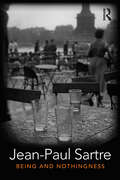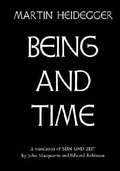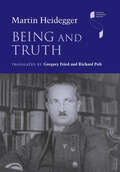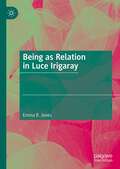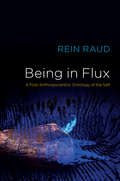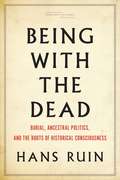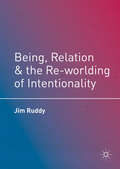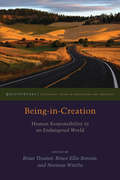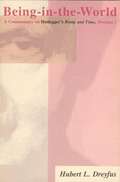- Table View
- List View
Being and Knowing: Reflections of a Thomist (The Library of Conservative Thought)
by Frederick D. WilhelmsenFrederick D. Wilhelmsen's Being and Knowing, rooted in the philosophy of St. Thomas Aquinas, rests on two basic assertions: first, metaphysics is the science of being in its first and ultimate act, existence (the act by which all things manifest themselves); second, that existence is known not through observing objects, but in affirming through judgments that these objects are subjects of existence.The chapters of this book explore these Thomistic doctrines. Some explain St. Thomas Aquinas's philosophy of being. Others probe his epistemology. The complexity and density of Aquinas's theory of judgment (that truth is realized in the judgment of man), emphasized throughout most of the book, point not only to a deeper understanding of the nature of metaphysics, but they open doors to the clarification of philosophical issues germane to contemporary thought.This work addresses a number of metaphysical philosophical paradoxes. Wilhelmsen's exploration of them demonstrates why he was the preeminent American scholar of the Thomistic tradition. This volume is part of Transaction's series, the Library of Conservative Thought.
Being and Logos: Reading the Platonic Dialogues (The\collected Writings Of John Sallis Ser. #I, 2)
by John SallisAn exercise in the careful reading of the dialogues in their originary character.“Being and Logos is . . . a philosophical adventure of rare inspiration . . . Its power to illuminate the text . . . its ecumenicity of inspiration, its methodological rigor, its originality, and its philosophical profundity—all together make it one of the few philosophical interpretations that the philosopher will want to re-read along with the dialogues themselves. A superadded gift is the author’s prose, which is a model of lucidity and grace.” —International Philosophical Quarterly“Being and Logos is highly recommended for those who wish to learn how a thoughtful scholar approaches Platonic dialogues as well as for those who wish to consider a serious discussion of some basic themes in the dialogues.” —The Academic Reviewer
Being and Logos: Reading the Platonic Dialogues (The\collected Writings Of John Sallis Ser. #I, 2)
by John SallisAn exercise in the careful reading of the dialogues in their originary character.“Being and Logos is . . . a philosophical adventure of rare inspiration . . . Its power to illuminate the text . . . its ecumenicity of inspiration, its methodological rigor, its originality, and its philosophical profundity—all together make it one of the few philosophical interpretations that the philosopher will want to re-read along with the dialogues themselves. A superadded gift is the author’s prose, which is a model of lucidity and grace.” —International Philosophical Quarterly“Being and Logos is highly recommended for those who wish to learn how a thoughtful scholar approaches Platonic dialogues as well as for those who wish to consider a serious discussion of some basic themes in the dialogues.” —The Academic Reviewer
Being and Neonness, Translation and content revised, augmented, and updated for this edition by Luis de Miranda (The\mit Press Ser.)
by Luis De MirandaA cultural and philosophical history of neon, from Paris in the twentieth century to the perpetually switched-on present day.For most of us, the word neon conjures images of lights, colors, nightlife, and streets. It evokes the poetry of city nights. For Luis de Miranda, neon is a subject of philosophical curiosity. Being and Neonness is a cultural and philosophical history of neon, from early twentieth-century Paris to the electric, perpetually switched-on present day Manhattan. It is an inspired journey through a century of night, deciphering the halos of the past and the reflections of the present to shed light on the future.Invented in Paris in 1912, neon first appeared on a modest but arresting sign outside a small barbershop; the sign lit up number 14, Boulevard Montmartre, attracting so many passersby that the barber's revenues soon doubled. A century later, neon is no longer just a sign; it is a mythic object—a metonymy of contemporary identity and a metaphor for the present, signifying the ubiquity of commerce and the tautology of hypermodernity. But perhaps the noble gas of neon whispers something more, something deeper? In ten short, poetic yet precise chapters, de Miranda explores the neon lights of the twentieth century. He considers, among other historical curiosities, the neon compulsions of the Italian Futurists; the Soviet program of “neonization”; the Nazi's deployment of neon for propaganda purposes; Baudelaire's “halo” and Benjamin's “aura”; neon as a gas and crystallized chaos; neon and power; neon and capitalism—all of this backlit by an original reading of Sartre's Being and Nothingness. This English edition has been thoroughly revised and adapted from the French edition, L'être et le neon.
Being and Nothingness
by Jean-Paul SartreA philosophical classic and major cornerstone of modern existentialism often criticized and all-too-rarely understood, the philosophy of Jean-Paul Sartre encompasses the dilemmas and aspirations of the individual in contemporary society. Being and Nothingness contains all the basic tenets of his thought, as well as all its more intricate details. A work of inherent force and epic scope, it provides a vivid analysis for all who would understand one of the most influential philosophic movements of any age, and makes clear why The New York Times hailed Sartre's masterpiece as "a philosophy to be reckoned with, both for its own intrinsic power and as a profound symptom of our time. " Hazel E. Barnes has translated and provided an introduction and notes.
Being and Nothingness: An Essay On Phenomenological Ontology (Routledge Classics Ser.)
by Jean-Paul SartreRevisit one of the most important pillars in modern philosophy with this new English translation—the first in more than 60 years—of Jean-Paul Sartre&’s seminal treatise on existentialism. &“This is a philosophy to be reckoned with, both for its own intrinsic power and as a profound symptom of our time&” (The New York Times).In 1943, Jean-Paul Sartre published his masterpiece, Being and Nothingness, and laid the foundation of his legacy as one of the greatest twentieth century philosophers. A brilliant and radical account of the human condition, Being and Nothingness explores what gives our lives significance. In a new and more accessible translation, this foundational text argues that we alone create our values and our existence is characterized by freedom and the inescapability of choice. Far from being an internal, passive container for our thoughts and experiences, human consciousness is constantly projecting itself into the outside world and imbuing it with meaning. Now with a new foreword by Harvard professor of philosophy Richard Moran, this clear-eyed translation guarantees that the groundbreaking ideas that Sartre introduced in this resonant work will continue to inspire for generations to come.
Being and Nothingness: An Essay in Phenomenological Ontology
by Jean-Paul SartreFirst published in French in 1943, Jean-Paul Sartre’s L’Être et le Néant is one of the greatest philosophical works of the twentieth century. In it, Sartre offers nothing less than a brilliant and radical account of the human condition. The English philosopher and novelist Iris Murdoch wrote to a friend of "the excitement – I remember nothing like it since the days of discovering Keats and Shelley and Coleridge". This new translation, the first for over sixty years, makes this classic work of philosophy available to a new generation of readers. What gives our lives significance, Sartre argues in Being and Nothingness, is not pre-established for us by God or nature but is something for which we ourselves are responsible. At the heart of this view are Sartre’s radical conceptions of consciousness and freedom. Far from being an internal, passive container for our thoughts and experiences, human consciousness is constantly projecting itself into the outside world and imbuing it with meaning. Combining this with the unsettling view that human existence is characterized by radical freedom and the inescapability of choice, Sartre introduces us to a cast of ideas and characters that are part of philosophical legend: anguish; the "bad faith" of the memorable waiter in the café; sexual desire; and the "look" of the Other, brought to life by Sartre’s famous description of someone looking through a keyhole. Above all, by arguing that we alone create our values and that human relationships are characterized by hopeless conflict, Sartre paints a stark and controversial picture of our moral universe and one that resonates strongly today. This new translation includes a helpful Translator’s Introduction, a comprehensive Index and a Foreword by Richard Moran, Brian D. Young Professor of Philosophy, Harvard University, USA. Translated by Sarah Richmond, University College London, UK.
Being and Time
by Martin HeideggerWhat is the meaning of being?" This is the central question of Martin Heidegger's profoundly important work, in which the great philosopher seeks to explain the basic problems of existence. A central influence on later philosophy, literature, art, and criticism--as well as existentialism and much of postmodern though.
Being and Truth (Studies in Continental Thought)
by Martin HeideggerA “well-crafted and careful rendering of an important and demanding volume” covering the philosopher’s views on language, life, and politics (Andrew Mitchell, Emory University).In these lectures, delivered in 1933-1934 while he was Rector of the University of Freiburg and an active supporter of the National Socialist regime, Martin Heidegger addresses the history of metaphysics and the notion of truth from Heraclitus to Hegel.First published in German in 2001, these two lecture courses offer a sustained encounter with Heidegger’s thinking during a period when he attempted to give expression to his highest ambitions for a philosophy engaged with politics and the world. While the lectures are strongly nationalistic, they also attack theories of racial supremacy in an attempt to stake out a distinctively Heideggerian understanding of what it means to be a people. This careful translation offers valuable insight into Heidegger’s views on language, truth, animality, and life, as well as his political thought and activity.
Being and Value in Technology
by Enrico Terrone Vera TripodiDespite numerous publications on the philosophy of technology, little attention has been paid to the relationship between being and value in technology, two aspects which are usually treated separately. This volume addresses this issue by drawing connections between the ontology of technology on the one hand and technology’s ethical and aesthetic significance on the other. The book first considers what technology is and what kind of entities it produces. Then it examines the moral implications of technology. Finally, it explores the connections between technology and the arts.
Being and Worth (Critical Realism: Interventions (Routledge Critical Realism))
by Andrew CollierBeing and Worth extends recent depth-realist philosophy to the question of values. It argues that beings both in the natural and human worlds have worth in themselves, whether we recognise it or not. This view is defended through and account of the human mind as essentially concerned with that of which it is independent. Conclusions follow both for environmental ethics - that natural beings should be valued for themselves, not just for their use to us - and for justice in the human world, based on the idea that humans are unique and equal in respect of 'having a life to live'.
Being and becoming: A guide to act in the theatre of existence
by Jose Luis Perez Velazquez Vera NenadovicMany people spend considerable time seeking a sense of purpose in life and, concomitant with that, a sense of personal identity. This book demystifies this search, revealing why this search is a fallacy. The purpose is to inform readers about results in neuroscience and biophysics that may guide us to some liberation needed in the current age of great complexity in life with a diverse burden of chores; a deliverance from some afflictions that prevent individuals from achieving the true purpose of our lives. Among these afflictions we find two primordial concerns: the belief and subsequent attachment to a self, and the conviction that life must have a deep purpose in which we are major players. While this is a scientific text, it can easily be read by a lay audience, written with minimal technical jargon and with references to scientific papers enough to satisfy the curious. We have tried to extract the essence of scientific observations such that we can glimpse at those aforementioned concerns about the self and life, observations which help us comprehend what we are and what we become, the being and becoming of our own selves and natural phenomena around us. Jose Luis Perez Velazquez received a PhD in Molecular Physiology & Biophysics. His research seeks principles of biological organisation. He worked at the Hospital for Sick Children in Toronto and was Professor at the University of Toronto. Currently he is a Research Scholar at the Ronin Institute and lives in the natural paradise of Asturias, in Northern Spain. Vera Nenadovic is a nurse practitioner, neuroscientist and entrepreneur. She has 30 years of experience in healthcare from First Nations communities to intensive care units. Her research focuses on predicting brain injury outcomes. She is a clinician and researcher at Holland Bloorview Kids Rehab Hospital. Her startup company BrainsView is commercializing software that analyzes brainwaves to monitor brain function and recovery after head injury. She is married and lives in Toronto, with her husband and Rottweiler.
Being as Communion: A Metaphysics of Information (Routledge Science and Religion Series)
by William A. DembskiFor a thing to be real, it must be able to communicate with other things. If this is so, then the problem of being receives a straightforward resolution: to be is to be in communion. So the fundamental science, indeed the science that needs to underwrite all other sciences, is a theory of communication. Within such a theory of communication the proper object of study becomes not isolated particles but the information that passes between entities. In Being as Communion philosopher and mathematician William Dembski provides a non-technical overview of his work on information. Dembski attempts to make good on the promise of John Wheeler, Paul Davies, and others that information is poised to replace matter as the primary stuff of reality. With profound implications for theology and metaphysics, Being as Communion develops a relational ontology that is at once congenial to science and open to teleology in nature. All those interested in the intersections of theology, philosophy and science should read this book.
Being as Relation in Luce Irigaray
by Emma R. JonesMany scholars have struggled with Irigaray’s focus on sexuate difference, in particular with her claim that it is “ontological,” wondering if this implies a problematically naïve or essentialist account of sexuate difference. As a result, the ethical vision which Irigaray elaborates has not been taken up in a robust way in the fields of philosophy, feminism, or psychoanalysis.By tracing the notion of relation throughout Irigaray’s work, this book identifies a rigorous philosophical continuity between the three self-identified “phases” in Irigaray’s thought (despite some critics’ concerns that there is a discontinuity between these phases) and clarifies the relational ontology that underlies Irigaray’s conceptualization of sexuate difference – one that always already implies an ethical project.The text demonstrates that an understanding of Irigaray’s Heideggerian inheritance – especially prominent in her later texts – is essential to grasping the sense of the idea that sexuate difference is ontological – it concerns Being, rather than beings. This book further develops potential applications of this ontological notion of a “relational limit” for the fields of philosophy, feminism, and psychotherapy.
Being at Large: Freedom in the Age of Alternative Facts
by Santiago ZabalaPoliticians and philosophers presenting themselves as the ultimate bearers of truth and reality have created unprecedented technological, cultural, and political framings. This new order conspires to undermine the interpretive practices of open-ended critique, normalizing a sense of threat to preserve control. The greatest emergency has become the absence of emergencies. Tracing an intellectual alliance between academics such as Jordan Peterson and Christina Hoff Sommers and right-wing populist politicians such as Donald Trump and Marine Le Pen, this book denounces framings that make a claim to objectivity. With the help of contemporary thinkers including Bruno Latour, Judith Butler, and Giorgio Agamben, as well as discussion of the Cambridge Analytica whistleblower Christopher Wylie and the emergency of biodiversity loss due to climate change, Santiago Zabala illustrates that the twenty-first-century question is not whether we can be free, but how to be at large - unconstrained by the new realist order. Being at Large demonstrates the anarchic power of hermeneutics, calling for interpretive disruptions of the authoritarian narrative as a way of reclaiming freedom in the age of alternative facts.
Being at Large: Freedom in the Age of Alternative Facts
by Santiago ZabalaPoliticians and philosophers presenting themselves as the ultimate bearers of truth and reality have created unprecedented technological, cultural, and political framings. This new order conspires to undermine the interpretive practices of open-ended critique, normalizing a sense of threat to preserve control. The greatest emergency has become the absence of emergencies. Tracing an intellectual alliance between academics such as Jordan Peterson and Christina Hoff Sommers and right-wing populist politicians such as Donald Trump and Marine Le Pen, this book denounces framings that make a claim to objectivity. With the help of contemporary thinkers including Bruno Latour, Judith Butler, and Giorgio Agamben, as well as discussion of the Cambridge Analytica whistleblower Christopher Wylie and the emergency of biodiversity loss due to climate change, Santiago Zabala illustrates that the twenty-first-century question is not whether we can be free, but how to be at large - unconstrained by the new realist order. Being at Large demonstrates the anarchic power of hermeneutics, calling for interpretive disruptions of the authoritarian narrative as a way of reclaiming freedom in the age of alternative facts.
Being in Flux: A Post-Anthropocentric Ontology of the Self
by Rein RaudReality exists independently of human observers, but does the same apply to its structure? Realist ontologies usually assume so: according to them, the world consists of objects, these have properties and enter into relations with each other, more or less as we are accustomed to think of them. Against this view, Rein Raud develops a radical process ontology that does not credit any vantage point, any scale or speed of being, any range of cognitive faculties with the privilege to judge how the world ‘really’ is. In his view, what we think of as objects are recast as fields of constitutive tensions, cross-sections of processes, never in complete balance but always striving for it and always reconfiguring themselves accordingly. The human self is also understood as a fluctuating field, not limited to the mind but distributed all over the body and reaching out into its environment, with different constituents of the process constantly vying for control. The need for such a process philosophy has often been voiced, but rarely has there been an effort to develop it in a systematic and rigourous manner that leads to original accounts of identity, continuity, time, change, causality, agency and other topics. Throughout his new book, Raud engages with an unusually broad range of philosophical schools and debates, from New Materialism and Object-Oriented Ontology to both phenomenological and analytical philosophy of mind, from feminist philosophy of science to neurophilosophy and social ontology. Being in Flux will be of interest to students and scholars in philosophy and the humanities generally and to anyone interested in current debates about realism, materialism and ontology.
Being in Time: Selves and Narrators in Philosophy and Literature (Ideas)
by Genevieve LloydGenevieve Lloyd's book is a provocative and accessible essay on the fragmentation of the self as explored in philosophy and literature. The past is irrevocable, consciousness changes as time passes: given this, can there ever be such a thing as the unity of the self? Being in Time explores the emotional aspects of the human experience of time, commonly neglected in philosophical investigation, by looking at how narrative creates and treats the experience of the self as fragmented and the past as 'lost'. It shows the continuities, and the contrasts, between modern philosophic discussions of the instability of the knowing subject, treatments of the fragmentation of the self in the modern novel and older philosophical discussions of the unity of consciousness. Being in Time combines theoretical discussion with human experience: it will be valuable to anyone interested in the relationship between philosophy and literature, as well as to a more general audience of readers who share Augustine's experience of time as making him a 'problem to himself'.
Being of Two Minds: Modernist Literary Criticism and Early Modern Texts
by Jonathan GoldbergBeing of Two Minds examines the place that early modern literature held in Modernist literary criticism. For T. S. Eliot, Virginia Woolf, and William Empson, the early modern period helps model a literary future. At stake in their engagements across time were ontological questions about literature and its ability to mediate between the one and the many, the particular and the general, life and death, the past and the present. If reading and writing literature enables the mind to be in two places at once, creative experience serves as a way to participate in an expanded field of consciousness alongside mortality.Goldberg reads the readings that these modernists performed on texts that Eliot claimed for the canon like the metaphysical poets and Jacobean dramatists, but also Shakespeare, Milton, Montaigne, and Margaret Cavendish. Ontological concerns are reflected in Eliot’s engagement with Aristotle’s theory of the soul and Empson’s Buddhism. These arguments about being affect minds and bodies and call into question sexual normativity: Eliot glances at a sodomitical male-male mode of literary transmission; Woolf produces a Judith Shakespeare to model androgynous being; Empson refuses to distinguish activity from passivity to rewrite gender difference.The work of one of our leading literary and cultural critics, Being of Two Minds spans centuries to show how the most compelling and surprising ideas about mind, experience, and existence not only move between early modernity, high modernism, and our own moment, but are also constituted through that very movement between times and minds.
Being with the Dead: Burial, Ancestral Politics, and the Roots of Historical Consciousness (Cultural Memory in the Present)
by Hans RuinPhilosophy, Socrates declared, is the art of dying. This book underscores that it is also the art of learning to live and share the earth with those who have come before us. Burial, with its surrounding rituals, is the most ancient documented cultural-symbolic practice: all humans have developed techniques of caring for and communicating with the dead. The premise of Being with the Dead is that we can explore our lives with the dead as a cross-cultural existential a priori out of which the basic forms of historical consciousness emerge. Care for the dead is not just about the symbolic handling of mortal remains; it also points to a necropolitics, the social bond between the dead and living that holds societies together—a shared space or polis where the dead are maintained among the living. Moving from mortuary rituals to literary representations, from the problem of ancestrality to technologies of survival and intergenerational communication, Hans Ruin explores the epistemological, ethical, and ontological dimensions of what it means to be with the dead. His phenomenological approach to key sources in a range of fields gives us a new perspective on the human sciences as a whole.
Being, Relation, and the Re-worlding of Intentionality
by Jim RuddyIn this book, Jim Ruddy has proceeded deep into the hub-center of Husserl's transcendental subjectivity and unearthed an utterly new phenomenological method. A vast, originative a priori science emerges for the reader. Ruddy presents a unique and powerful eidetic science wherein the object consciousness of Husserl is suddenly shown to point beyond itself to the ultimate theme of the pure subject consciousness of God as He is in Himself. Thus, the book opens up an endlessly new, unrestricted realm of objective material for phenomenology to exfoliate and describe. This is an important work for both general phenomenologists and for scholars of Husserl, Aquinas, and Edith Stein.
Being-in-Creation: Human Responsibility in an Endangered World (Groundworks: Ecological Issues in Philosophy and Theology)
by Bruce Ellis Benson Norman WirzbaWhat is the proper relationship between human beings and the more-than-human world? This philosophical question, which underlies vast environmental crises, forces us to investigate the tension between our extraordinary powers, which seem to set us apart from nature, even above it, and our thoroughgoing ordinariness, as revealed by the evolutionary history we share with all life.The contributors to this volume ask us to consider whether the anxiety of unheimlichkeit, which in one form or another absorbed so much of twentieth-century philosophy, might reveal not our homelessness in the cosmos but a need for a fundamental belongingness and implacement in it.
Being-in-the-World: A Commentary on Heidegger's Being and Time Division I
by Hubert L. DreyfusDreyfus's approach to this daunting book is straightforward and pragmatic. He explains the text by frequent examples drawn from everyday life, and he skillfully relates Heidegger's ideas to the questions about being and mind that have preoccupied a generation of cognitive scientists and philosophers of mind.
Beings of Thought and Action: Epistemic and Practical Rationality
by Andy MuellerIn this book, Andy Mueller examines the ways in which epistemic and practical rationality are intertwined. In the first part, he presents an overview of the contemporary debates about epistemic norms for practical reasoning, and defends the thesis that epistemic rationality can make one practically irrational. Mueller proposes a contextualist account of epistemic norms for practical reasoning and introduces novel epistemic norms pertaining to ends and hope. In the second part Mueller considers current approaches to pragmatic encroachment in epistemology, ultimately arguing in favor of a new principle-based argument for pragmatic encroachment. While the book defends tenets of the knowledge-first programme, one of its main conclusions is thoroughly pragmatist: in an important sense, the practical has primacy over the epistemic.
Belief Functions: 6th International Conference, BELIEF 2021, Shanghai, China, October 15–19, 2021, Proceedings (Lecture Notes in Computer Science #12915)
by Frédéric Pichon Thierry Denœux Eric Lefèvre Zhunga LiuThis book constitutes the refereed proceedings of the 6th International Conference on Belief Functions, BELIEF 2021, held in Shanghai, China, in October 2021. The 30 full papers presented in this book were carefully selected and reviewed from 37 submissions. The papers cover a wide range on theoretical aspects on mathematical foundations, statistical inference as well as on applications in various areas including classification, clustering, data fusion, image processing, and much more.
